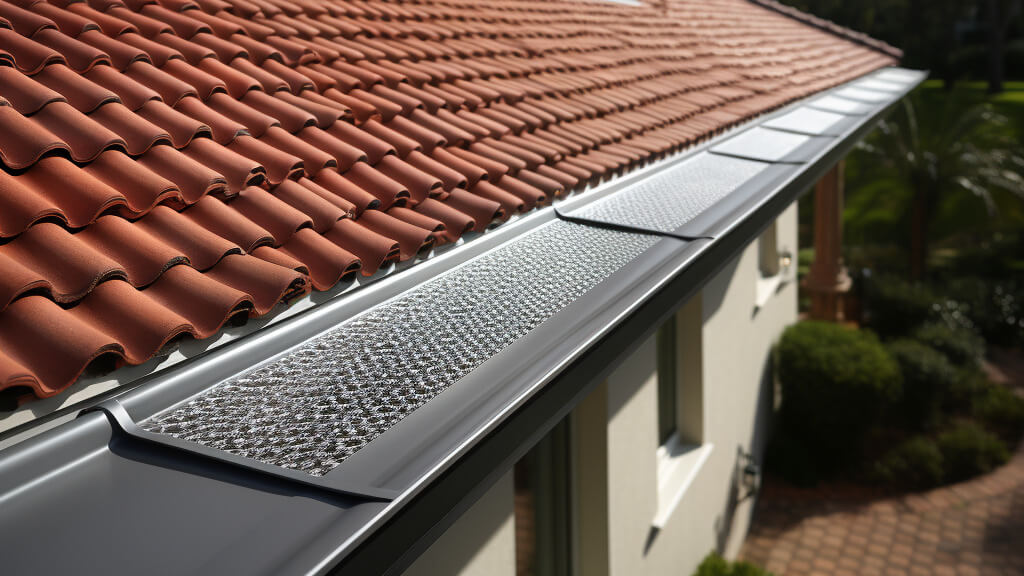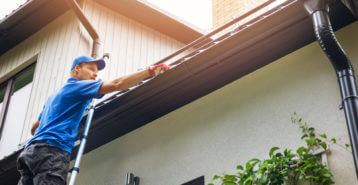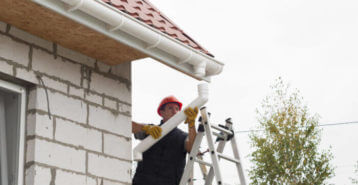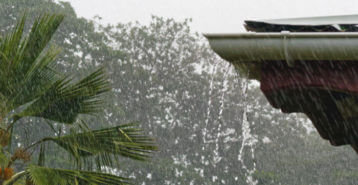What Are the Different Gutter Guard Types?
If you’re tired of cleaning out your gutters or dealing with water damage after every storm, gutter guards might be the upgrade your home needs. From mesh screens to reverse-curve covers, there are several gutter guard types to choose from, each with its own pros, cons, and price points. In this guide, we’ll break down the most common types so you can find the best fit for your home and budget. Keep reading to learn how the right gutter guard can save you time, protect your home, and cut down on seasonal maintenance.
How Much Do Gutter Guards Cost?
On average, gutter guard installation costs range from $3 to $25 per linear foot, or $800 to $5,000 depending on the type of guard and installation complexity. Higher-end systems typically fall on the costly side of that range, but they also tend to offer better durability, longer lifespans, and professional installation services.
| Gutter Guard Type | Average Cost per Linear Foot |
|---|---|
| Screen Mesh | $1.50 - $6.00 |
| Solid Surface | $5.00 - $10.00 |
| Micro-Mesh | $8.00 - $25.00 |
| Foam Inserts | $2.00 - $3.00 |
| Bottle Brush | $3.00 - $5.00 |
Looking for costs by brand?
Here’s what you can expect to pay for some of the most well-known gutter guard brands:
- LeafFilter: $10 to $30 per linear foot, or about $3,000 to $8,000 for a full installation
- LeafGuard: $15 to $45 per linear foot, or roughly $3,000 to $9,000 total
These price ranges include professional installation and vary based on your home’s size, gutter condition, and the complexity of the job. Always compare quotes to get the best value for your project.
Need a breakdown of costs by material, square footage, or gutter guard types? Check out our full gutter guard cost guide to compare your options and get a better sense of what fits your budget. Or tap the banner below to see personalized gutter system costs.
5 Common Types of Gutter Guards
When comparing gutter guard types, it’s important to weigh cost, performance, and maintenance needs. Below are the five most common types, each with a cost range and pros and cons to help you find the right fit for your home.
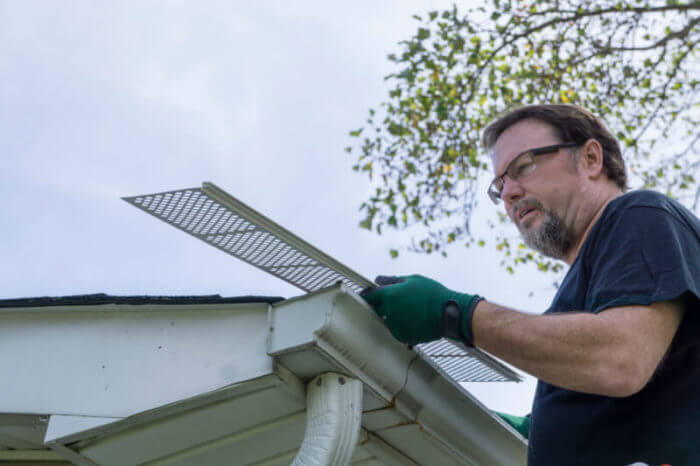
1. Screen Gutter Guards
- Cost: $1.50 to $6.00 per linear foot
- DIY-Friendly: Yes
- Best for: Basic leaf and debris protection
Screen guards are one of the most affordable and widely used gutter guard types. They’re made from aluminum, plastic, or wire mesh and rest over the top of your gutter, blocking larger debris like leaves and twigs.
They’re easy to install yourself and work well in areas with moderate leaf fall. However, they may allow smaller debris to pass through, requiring periodic cleaning to prevent clogs. Metal screens are more durable and should be inspected and cleaned at least twice a year for optimal performance.
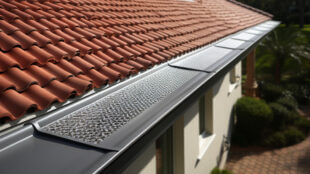
2. Mesh Gutter Guards
- Cost: $1.50 to $10.00 per linear foot
- DIY-Friendly: Not typically
- Best for: Smaller debris and finer filtration
Mesh guards function like screens but with finer holes for better filtration. Micro-mesh versions can block pine needles, seeds, and other tiny particles that screens let through. They offer excellent protection but usually require professional installation.
These guards are a great long-term solution, especially for homes surrounded by trees that drop fine debris. However, heavy rain can sometimes overwhelm micro-mesh guards, causing water to overshoot the gutter. Be sure to select a design that balances debris protection with water flow.
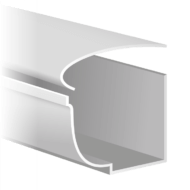
3. Reverse Curve (Surface Tension)
- Cost: $3.00 to $25.00 per linear foot
- DIY-Friendly: No
- Best for: Long-term protection and curb appeal
Reverse curve gutter guards, also called surface tension guards, guide water over a curved surface into the gutter while debris slides off the edge. They’re designed for durability and are often color-matched to blend in with your roofline.
They’re popular for their sleek appearance and effectiveness at blocking large debris. But since they’re visible from the ground, not everyone prefers the aesthetic. These guards must be installed by a professional, and in some cases, lifting shingles to install them can void a roof warranty.
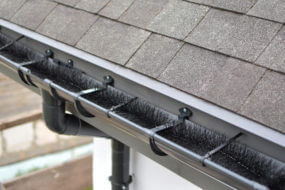
4. Bottle Brush Gutter Guards
- Cost: $3.00 to $4.25 per linear foot
- DIY-Friendly: Yes
- Best for: Quick, temporary protection
Bottle brush guards are made of bristle-like materials that sit inside the gutter. Water flows through while the bristles trap leaves and other debris on top. They’re simple to install and easy to remove for cleaning.
These are ideal for homeowners looking for a low-cost, low-commitment solution. However, they may trap small debris within the bristles, requiring regular removal and shaking out. They’re best used in areas with light to moderate foliage and work well as a seasonal or temporary option.
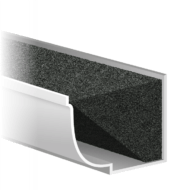
5. Foam or Sponge Gutter Guards
- Cost: $2.00 to $3.25 per linear foot
- DIY-Friendly: Yes
- Best for: Short-term or emergency use
Foam gutter guards are inserted directly into the gutter channel. Their porous material lets water through while keeping debris out. They’re budget-friendly and available at most home improvement stores.
While great in a pinch, especially before storms, they’re not a long-term fix. Foam can deteriorate over time, become clogged, or even freeze in cold weather, which may block water flow. They also have a higher risk of mold or mildew buildup, so plan to replace or clean them frequently.
How Do Gutter Guards Work?
Gutter guards are a smart way to protect your home and cut down on seasonal gutter cleaning. Installed over or inside your gutters, depending on the type, they act as a barrier that lets water in while keeping leaves, twigs, and other debris out.
Here’s how they work:
- Water flows through the gutter guard and into your gutter system.
- Leaves, pine needles, and other debris are blocked before they can clog your gutters.
- Depending on the gutter guard type, debris may blow away naturally or need to be cleared from the top occasionally.
Without gutter guards, your system can quickly clog, especially in the fall or after storms. That can lead to overflow, water damage, and even foundation issues. While no system is 100% maintenance-free, most gutter guards help reduce clogs and extend the life of your gutters, saving you time and protecting your home in the long run.
Pros of Gutter Guards
- Protect Your Home From Costly Damage: Gutter guards help prevent clogs caused by leaves, twigs, and ice. This reduces the risk of water overflow, foundation issues, and structural damage, especially during heavy rain or winter storms.
- Keep Pests out of Your Gutters: Covered systems make it harder for birds, rodents, and insects to nest or breed. By limiting access to standing water and shelter, gutter guards help prevent infestations.
- Reduce Fire Risks in Dry Climates: In wildfire-prone areas, windblown embers can ignite dry debris sitting in gutters. Gutter guards help keep these materials out, lowering the chance of fire hazards.
- Cut Down on Gutter Cleaning: With less debris to deal with, your gutters require less maintenance throughout the year. Guards also reduce rust, corrosion, and the wear that leads to early replacements.
- Minimize Mold and Mildew Buildup: Blocking moisture-holding debris helps reduce mold growth inside your gutters and roofline. Cleaner gutters also help protect your foundation from moisture-related damage.
Cons of Gutter Guards
- They Come With an Upfront Cost: Gutter guard installation ranges from $460 to $4,000 depending on the type, material, and whether you hire a pro. DIY-friendly options like foam or brush guards are cheaper but typically less effective.
- Some Debris Can Still Get Through: Tiny materials like pine needles or seeds may slip through certain gutter guard types. While guards reduce cleaning, occasional maintenance is still needed to clear buildup and prevent moss or algae growth.
- They Add Extra Weight to Your Gutter System: Some guard systems can weigh down gutters, especially if not cleaned regularly. This may cause sagging or stress on your roof. Always check with a professional to ensure compatibility with your existing gutters and structure.
Finding an Experienced Gutter Professional
Ready to install gutter guards? The right pro can make all the difference. An experienced gutter installer will evaluate your home, recommend the best gutter guard types for your needs and climate, and ensure everything is installed properly.
Think about your long-term goals. Are you looking for a quick, budget-friendly DIY fix or a durable, low-maintenance solution that lasts for years? Either way, a licensed contractor can help you make the smartest investment.
Modernize makes it easy to find trusted, local gutter professionals. We’ll connect you with vetted pros who can guide you through the selection process and handle your installation with confidence.
Compare top-rated gutters pros in your area.
Read real homeowner reviews, explore qualifications, and view promotions. Modernize makes it easy to browse professionals and find one that will be perfect for your project.
